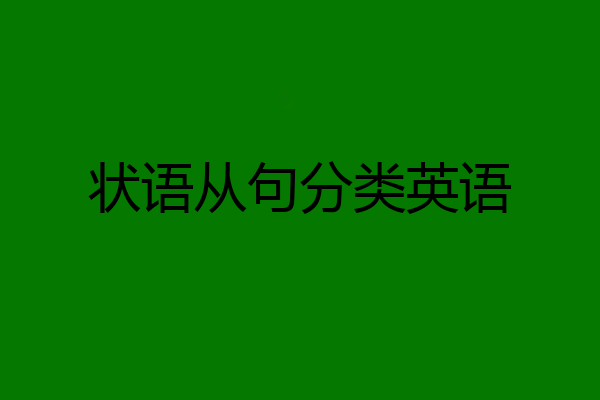 笑脸笑脸笑脸
笑脸笑脸笑脸
共5条回答163浏览
-
-

状语从句的类型:时间状语从句、地点状语从句、原因状语从句、目的状语从句等。时间状语从句:凡是从句都必须有引导词,引导时间状语从句的词有when,before,after,until,as soon as,while 等。条件状语从句:主要看一下由if引导的条件状语从句。
一、时间状语从句
I didn’t realize how special my mother was until I became an adult. 直到我成为了一个成年人我才意识到我的母亲是多么的特殊。
While John was watching TV, his wife was cooking. 当约翰看电视时,他的妻子正在做饭。
The children ran away from the orchard(果园), the moment they saw the guard. 孩子们一看到守卫就逃出了果园。
No sooner had I arrived home than it began to rain. 我一到家就开始下雨了。
Every time I listen to your advice, I get into trouble. 每当我听取你的建议时,我就会惹上麻烦。
二、地点状语从句
常用引导词:where
特殊引导词:wherever, anywhere, everywhere
Generally, air will be heavily polluted where there are factories. 一般来说,有工厂的地方空气污染就严重。
Wherever you go, you should work hard. 无论你去哪里,你都应该努力工作。
地点状语从句一般由连接副词where, wherever等引导,已经形成了固定的句型,例如:
Where there is no rain, farming is difficult or impossible. 在没有雨水的地方,耕作是困难的或根本不可能的。
They were good persons. Where they went, there they were warmly welcomed. 他们都是好人。因此他们走到哪里都受到热烈欢迎。
You should have put the book where you found it. 你应该把书放回原来的地方。
Where the Communist Party of China goes, there the people are liberated. 哪里有了中国共产党,哪里的人民就得解放。
Wherever the sea is , you will find seamen. 有海就有海员。
三、原因状语从句
常用引导词:because, since, as,
特殊引导词:seeing that, now that, in that, considering that, given that.
My friends dislike me because I’m handsome and successful. 我的朋友都不喜欢我,因为我又英俊又成功。
Now that everybody has come, let’s begin our conference. 既然每个人都到了,让我们开始我们的会议吧。
The higher income tax is harmful in that it may discourage people from trying to earn more. 更高的收入税是有害的,因为它或许会阻碍人们努力赚钱。
四、目的状语从句
常用引导词:so that, in order that
特殊引导词:lest, in case, for fear that,in the hope that, for the purpose of , to the end that
The boss asked the secretary to hurry up with the letters so that he could sign them. 老板要求秘书快写函件以便他能在上面签字。
The teacher raised his voice on purpose that the students in the back could hear more clearly. 为了让后面的学生听得更清楚,老师有意地提高了他的声音。
注意,由for引导的是一个并列句,不是原因状语从句,但有表原因的意思,是并列连词。
五、结果状语从句
常用引导词:so … that, such … that, so that...
特殊引导词:such that, to the degree that, to the extent that, to such a degree that,
He got up so early that he caught the first bus. 他很早起床以便赶上第一班公共汽车
It’s such a good chance that we must not miss it. 这是一个好机会,千万不能错过它
To such a degree was he excited that he couldn’t sleep last night. 他激动到这个程度,以至于他昨晚睡不着
This news is exciting, so that he jumped up.
这个消息太令人激动了,以至于他跳了起来
六、条件状语从句
常用引导词:if, unless,whether(whether...or not)
特殊引导词:as/so long as, only if, providing/provided that, supposing that, in case(美语中表条件,英语中表目的), on condition that
We’ll start our project if the Psident agrees. 如果总统同意,我们将开始我们的项目
You will certainly succeed so long as you keep on trying. 只要你继续努力,你一定会成功的。
Provided that there is no opposition, we shall hold the meeting here. 如果没有人反对,我们就在这里开会。
七、让步状语从句
常用引导词:though, although, even if, even though
特殊引导词:as(用在让步状语从句中必须要倒装),while ( 一般用在句首 ),no matter …, in spite of the fact that, whatever, whoever, wherever, whenever, however, whichever
Much as I respect him, I can’t agree to his proposal. 尽管我很尊敬他, 但是我却不同意他的建议。
The old man always enjoys swimming even though the weather is rough. 老人都很喜欢游泳,即使天气很恶劣。
No matter how hard he tried, she could not change her mind. 不论他如何努力,她都不会改变她的主意。
He won’t listen whatever you may say. 他不会听你说什么。
八、比较状语从句
常用引导词:as(同级比较), than(不同程度的比较)
特殊引导词:the more … the more …(越来...越...) ; just as …, so…; A is to B what/as X is to Y; no … more than; not so much A as B,the 比较级 ,the 比较级.
She is as bad-tempered as her mother. 她和她妈妈一样脾气很坏。
The house is three times as big as ours. 这房子是我们的三倍大。
The more you exercise, the healthier you will be. 你运动的越多,你就越健康。
Food is to men what oil is to machine. 食物之于人,犹如油之于机器。。
九、方式状语从句
常用引导词:as, as if
特殊引导词:the way
When in Rome, do as the Romans do. 入国问禁,入乡随俗。
She behaved as if she were the boss. 她表现得好像她是老板。
Sometimes we teach our children the way our parents have taught us. 有时,我们用父母教导我们的方式教导我们的孩子。
十、状语从句的省略
状语从句同时具备下列两个条件:①主句和从句的主语一致,或从句主语为it;②从句主要动词是be的某种形式。从句中的主语和be动词常可省略。例如:
When ( the museum is ) completed , the museum will be open to the public next year . 当博物馆完成,该博物馆将于明年向公众开放。
He’ll go to the seaside for his holiday if (it is ) possible. 如果可能,他将去海边度假的话
另外,比较状语从句经常省略。例如:
I’m taller than he (is tall ). 我比他高
The higher the temperature (is), the greater the Pssure (is ). 温度越高,气压越大
就状语从句而言,有时为了使语言言简意赅,常常将状语从句进行"简化"。状语从句的"简化"现象在口语中较为普遍,而且在高考中的复现率也较高。因此,有必要对其进行全面、透彻的了解。
状语从句的"简化"现象常存在于以下五种状语从句中:①由if, unless等引导的条件状语从句;②由although, though, even if / though等引导的让步状语从句;③由when, while, as, before, after, until / till等引导的时间状语从句;④由as, as if等引导的方式状语从句;⑤由as, than等引导的比较状语从句。下面针对这五种情形作一归纳。
(1)当状语从句的主语是it,且谓语动词是be时,it和be要完全简化掉。例如:
If (it is) possible, he will help you out of the difficulty. 如果可能的话,他会帮你摆脱困境。
You must attend the meeting unless (it is) inconvenient to you。 除非情况对你来说不方便,否则你必须出席这次会议。
(2)当状语从句的主语和主句的主语一致时,从句可以将主语和be动词简化掉。常用于以下几种情形:
连词+形容词
As (he was) young, he learned how to ride a bike. 他小时候就学会了骑自行车。
Whenever (she is) free, she often goes shopping. 她有空就去逛商店。
Work hard when (you are) young, or you'll regret. 少壮不努力,老大徒伤悲。
-
-
-
时间状语从句,地点状语从句,条件状语从句,方式状语从句,原因状语从句,目的状语从句,结果状语从句,程度状语从句,让步状语从句,比较状语从句。
-
-
-
状语从句: 一个句子作状语,表达描述性的信息。 状: 理解为“描述” 状语从句有很多种,描述时间的叫时间状语从句,描述条件的叫条件状语从句。 状语从句的写法: 与宾语从句、定语从句类似,由陈述句和连接词构成,不同点在于状语从句的陈述句,必须是完整的。 写法是: 一个完整的陈述句 (主谓宾,不缺少任何成分), 前面加上从属连词 (用于说清楚整个句子是说什么的,例如句子表示时间就用时间连词,表示地点就用地点连词,它不作后面陈述句的成分,只是为了清楚地表示整个句子的逻辑关系)。 状语从句的关键 在于从属连词,与后面的陈述句关系不大,例如:从属连词是 if ,表示条件状语从句,如果是 because ,表示原因状语从句…… 根据从属连词进行分类,一共分为 九种 状语从句: 1、 时间状语从句 从属连词有: when ,while ,as ,before ,after ,since ,until ,as soon as ,no sooner …than 2、 地点状语从句 where 3、 原因状语从句 because , since , as 4、 结果状语从句 so…that , such …that (太…所以) so that …(所以) 5、目的状语从句 so that , in order that 6、 原因状语从句 if , unless (如果不),as long as 7、 让步状语从句 明让步,暗转折,一般翻译为:尽管… ; 虽然… although , though ,even though , as 8、 比较状语从句 than , as 9、 方式状语从句 as 按照…方式;像…一样
-
-
 纯度装饰9小时前发布
纯度装饰9小时前发布-
英语中的状语从句有:时间状语从句,地点状语从句,原因状语从句,条件状语从句,目的状语从句,结果状语从句,让步状语从句,比较状语从句~手工翻译,尊重劳动,欢迎提问,感谢采纳!~
-
-
-
状语从句主要用来修饰主句或主句的谓语.一般可分为九大类,分别表示时间、地点、原因、目的、结果、条件、让步、比较和方式.尽管种类较多,但由于状语从句与汉语结构和用法相似,所以理解和掌握它并不难.
-



